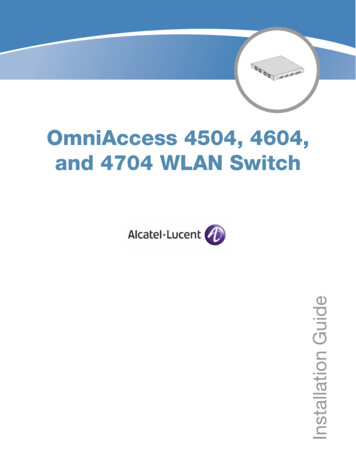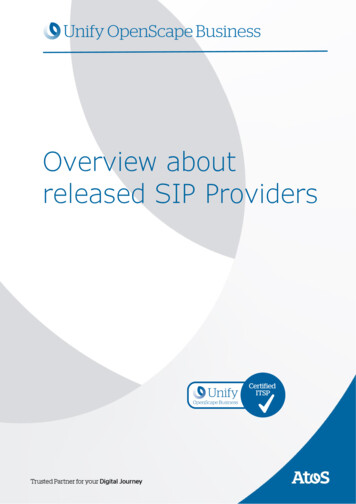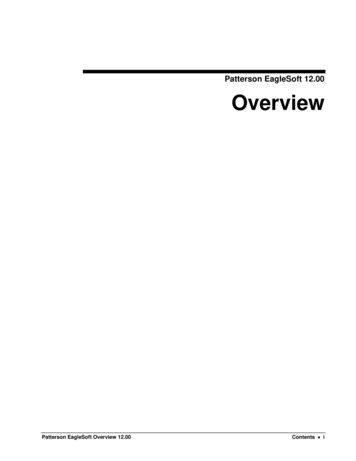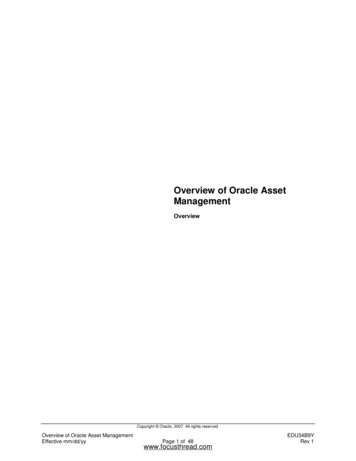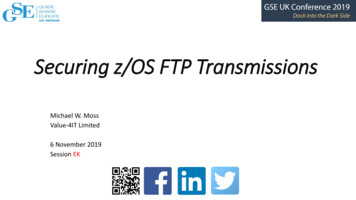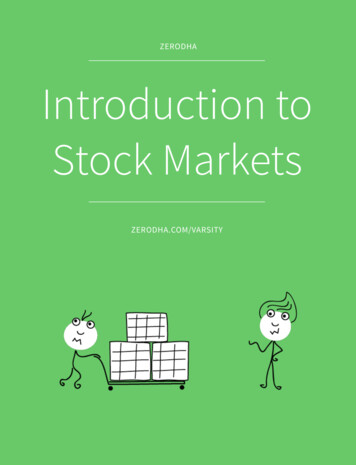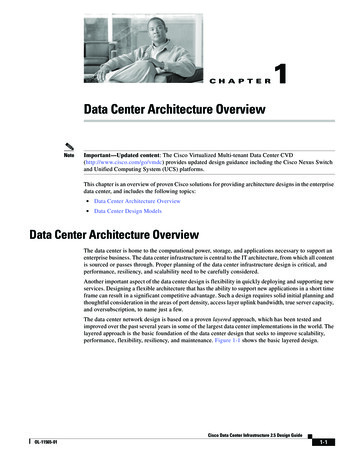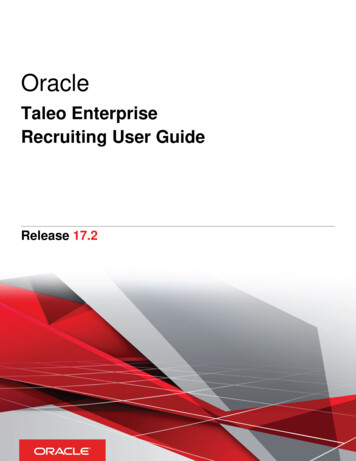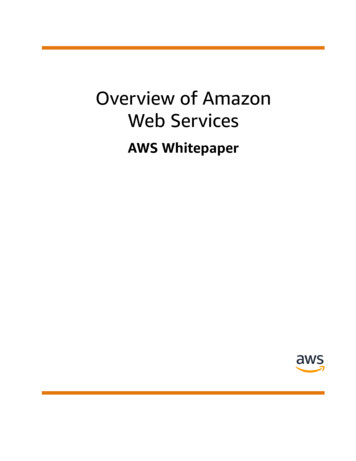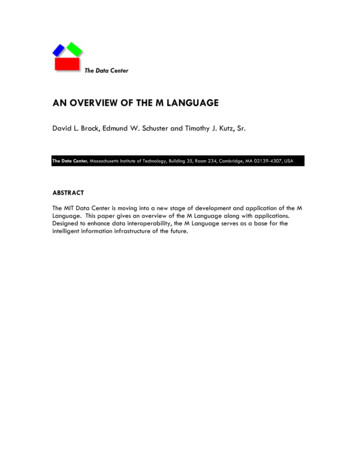
Transcription
The Data CenterAN OVERVIEW OF THE M LANGUAGEDavid L. Brock, Edmund W. Schuster and Timothy J. Kutz, Sr.The Data Center, Massachusetts Institute of Technology, Building 35, Room 234, Cambridge, MA 02139-4307, USAABSTRACTThe MIT Data Center is moving into a new stage of development and application of the MLanguage. This paper gives an overview of the M Language along with applications.Designed to enhance data interoperability, the M Language serves as a base for theintelligent information infrastructure of the future.
Published on January 12, 20062ABOUT THE AUTHORSDavid L. Brock is Principal Research Scientist at the Massachusetts Institute of Technology,and co-founder and a Director at the Auto-ID Center (now EPCGlobal, Inc. and Auto-IDLaboratories). The Center was an international research consortium formed as apartnership among more than 100 global companies and five leading researchuniversities. David is also Assistant Research Professor of Surgery at Tufts UniversityMedical School and Founder and Chief Technology Officer of endoVia Medical, Inc., amanufacturer of computer controlled medical devices. Dr. Brock holds bachelors’ degreesin theoretical mathematics and mechanical engineering, as well as master and Ph.D.Degrees, from MIT. Dave can be reached at dlb@mit.eduEdmund W. Schuster has held the appointment of Director, Affiliates Program in Logisticsat the MIT Center for Transportation and Logistics and is currently working at The DataCenter as Co-Director - Administration and researcher. His interests are the application ofmodels to logistical and planning problems experienced in industry. He has a bachelor ofscience from The Ohio State University and a master in public administration from GannonUniversity with an emphasis in management science. Ed also attended the executivedevelopment program for physical distribution managers at the University of Tennesseeand holds several professional certifications. Ed can be reached at edmund w@mit.edu.Timothy J. Kutz, Sr. is the Director of the Information Technology Management practice atMorganFranklin Corporation (MFC) and has responsibility for MFC’s partnership with theMIT Data Center. His information technology and management consulting experienceincludes both domestic and international engagements serving a variety of federal, state,and local governmental clients and fortune 500 commercial clients. He has a bachelor ofarts in business administration from Marymount University and an MBA from GeorgeMason University. He also holds a master’s certificate in Project Management fromGeorge Washington University. Timothy can be reached at Timothy.Kutz@MorganFranklin.com.The Data CenterMIT-DATACENTER-WH-009Copyright 2006 Massachusetts Institute of Technology
Published on January 12, 200631.0 INTRODUCTIONThe MIT Data Center envisions a world in which information flows freely within and acrossthe enterprise, where data from widely divergent sources merge seamlessly into acoherent whole, and where algorithms and software automatically combine with data toform a new intelligent information infrastructure.1,2 By creating an open, global languagethat communicates between propriety schemas, companies will have the ability to combine,visualize and understand data.3,4 This paper outlines the vision, approach, application,and benefits of this new initiative.2.0 M – THE BASICSThe M Language is conceptually simple, consisting of two parts – words and rules. In M,words take on a new form that allows for easier machine understanding. Rules provideguidelines about how to place words together for representing data or models in acommon format that is interoperable. These representations are in the form of messagesthat can be transferred between computing systems. The next two sections take a closerlook at the words and rules of the M Language.2.1 WordsThe words used in the M Language are slightly different from English words. In M, everyword has only one definition. This is an extremely important characteristic becausecomputers that communicate using M do not need to understand the context or usage of aword to know its meaning.English words are ambiguous. For example, the word “cell” might mean “cellular phone,”“biological cell,” “jail cell,” or “fuel cell.” Without some idea of the context, it isimpossible to know the meaning of the word “cell.”To overcome this issue, the M language includes a number to denote individual words suchas:cell.1To account for multiple definitions, the M Language allows numeric extensions, one foreach definition. Thus, cell.1 is a word in M and cell.2 is a different word. With thismethod, every word has one and only one meaning.In English, dictionaries define the meaning of a word. M also uses a dictionary. The MDictionary serves as a repository for definitions of words used in computer transactions.The dictionary also is a means of storing other important information associated with aThe Data CenterMIT-DATACENTER-WH-009Copyright 2006 Massachusetts Institute of Technology
Published on January 12, 20064particular word. This provides an effective means of unifying various aspects of a wordand forms a base for common computer-to-computer communication.2.1.1 The M DictionaryIn the M-Dictionary, words and definitions are stored in the following form:cell.1 -The basic structural and functional unit of all organisms; they mayexist as independent units of life (as in monads) or may formcolonies or tissues (as in higher plants and animals).This, of course, is the only definition for the word cell.1. Other words, such as cell.2, cell.3,and cell.4 all have different definitions expressed using the same format.In addition to the definition, the dictionary entry also contains three other pieces ofimportant information. These include (1) word relations, (2) data format, and (3)language translations. This information helps in forming and understanding messagescomposed in M.Word relations are simply the connections between words. These relationships includesynonyms, antonyms, types, and parts.5 Synonyms and antonyms are the same as inEnglish.Types refer to word generalizations. For example, automobile.1 is a type ofmotor vehicle.1.6Parts are words that are components of another word. This is often the case when thinkingabout physical objects, although this could also be the case with abstractions. Forexample, a wing.4 is a part of airplane.1.Data format provides guidance concerning the forms and patterns of data values thatmight be associated with a particular word. In many situations, computer-to-computercommunication might contain a word such as first name.1 that has an associated datavalue such as “John Smith”. Other common situations include words liketelephone number.1, account balance.1, or postal code.1. In all of these cases, aparticular format or pattern of data is attached to the word.Finally, the language translation portion is simply the representation of the word in M in aword (or phrase) in a human language. In most situations, computer-based languagetranslation is very difficult because of a lack of context for the specific communication.Since in M each word has only one definition, the word cell.1 (biological), for example,cannot be confused with cell.2 (telephone). Words with a single definition allow users tospecify exact meaning independent of context. This eliminates ambiguity in translation.2.1.2 Dictionary DevelopmentDeveloping common definitions for the words, data formats, and translations used incommerce along with the analysis of data across all industries has traditionally been aThe Data CenterMIT-DATACENTER-WH-009Copyright 2006 Massachusetts Institute of Technology
Published on January 12, 20065source of great debate within business. To build a robust global dictionary containing thewords used in the M Language along with other important information, such as relationsbetween words, associated data patterns and translations, requires a different approach.The “wiki” process has emerged as an innovative application of Internet technology toknowledge management and consensus building. A ‘wiki’ is a type of website that allowsusers to add and edit content and is especially suited to collaborative authoring.7Since 2001, Wikipedia has become the largest encyclopedia ever created with over 3million entries.8 The M Dictionary uses the wiki approach with several importantmodifications including improved security through user registration, maintenance of theintegrity of word relations, a monitoring function to reduce the chances of near identicaldefinitions, and administrative controls to ensure accuracy.However, having a robust dictionary is just a part of the M Language. To form messages,computers need a set of rules that give instructions on how to glue the words together. Thenext section discusses the rules of the M Language.2.2 RulesLanguage is more than just a collection of words defined by a dictionary. For mostlanguages, grammar gives explicit rules on the order of words to give meaning to asentence. In English, the simple sentence “Threw ball the Jack” is nonsensical. Establishingcorrect word order is essential. Thus the sentence “Jack threw the ball” formed byrearranging the words makes sense. From this example, it is clear that word order,sometimes called syntax, has an important role in communicating meaning. If words are inthe correct order, instant recognition takes place.Just as English has rules of grammar for word order, the M Language also has rulesestablishing the order needed for machine understanding of messages.The initial version of the M Language contains three simple rules. These three rules,however, represent a significant portion of computer-to-computer communication. Thethree are (1) phrases, (2) key-value pairs, and (3) tables.A phrase is a sequence of machine-understandable words representing a single idea. Aphrase in M is just like a phrase in English. The syntax is such that the last word in thephrase is the root and all the others are modifiers. As an example, the phrase “initialaccount balance” appears in M as:initial.1 account.1 balance.1In this phrase, balance.1 is the root word, while initial.1 and account.1 are modifiers.Phrases within the M Language represent a unit of meaning that is extremely useful inincreasing the precision of data element descriptions.The Data CenterMIT-DATACENTER-WH-009Copyright 2006 Massachusetts Institute of Technology
Published on January 12, 20066Key-value pairs are simply a list of words with associated data values. Tax forms,medical records, and financial statements are all representations of key-value pairs. Akey-value pairs example follows:Name.1 – “John Smith”Telephone number.1 – “(703)-459-1234”Key value pairs in the M Language are useful in making data interoperable within andexternal to the firm. Interoperable data opens a number of possibilities for combiningdata posted on the Internet with internal company data.The final rule involves tables, which are the most common way to store data on thecomputer. There are many different ways to represent tables, comma separated values(CSV), Excel spreadsheets, HTML tables, and others. In the M Language, a table takes onthe pattern of repeating sets of key value pairs, each with identical keys. The following isan example:patient.1name.1telephone number.1“John ne number.1“Robert Williams”“(703)-457-1234”Subsequent versions of M will include additional rules, such as rules for spatial data,equations, and mathematical models. Integrating spatial information, for example, will bevaluable in marketing, demographics, transportation, and logistics, while rules formathematical equations and algorithm will ultimately allow the integration of data andmodels.3.0 APPLICATIONThe M Language is a tool that enables the free flow of data and models across thenetwork. Achievement of this vision will result in a number of practical applications inindustry.3.1 Interoperable DataPerhaps the most obvious application of the M Language is as an intermediary betweenproprietary data systems. In this application, data from one database is translated intoM before it is communicated to another, as shown in Figure 1. Here data from a sourcesystem, is translated at the server into M. This data is sent over the network – either ashuman readable text or compact binary – to the target system. The data can then beThe Data CenterMIT-DATACENTER-WH-009Copyright 2006 Massachusetts Institute of Technology
Published on January 12, 20067used in the native M format or translated again into another proprietary schema andstored in the local database.In broad terms, the M Language serves as a common transport between distributed,incompatible data systems. The advantage of this approach is that data providers do notneed to know the format or content of every possible target application. Providers needonly expose data in the standard M language for their data to be interoperable. UsingM as a common carrier, translation takes place only once at the server instead of manytimes for every possible consumer.Figure 1. The M Language can serve as an intermediary between disparate,proprietary data systems, as well as a general interface for internetcommunication.The Data CenterMIT-DATACENTER-WH-009Copyright 2006 Massachusetts Institute of Technology
Published on January 12, 200683.2 BrowserThe M Language provides more than just a translation service. As a common language, Mencourages third-party developers to create a wide range of software tools andapplications. As a first step, the MIT Data Center has created a browser to view, edit,and manipulate data directly in M. The browser presents data in an easy-to-understandformat without the need for additional styling information. Sections are indented,headings aligned, data color-keyed and tables displayed properly as spreadsheets. Theapplication also provides data plotting functi
12.01.2006 · synonyms, antonyms, types, and parts.5 Synonyms and antonyms are the same as in English. Types refer to word generalizations. For example, automobile.1 is a type of motor_vehicle.1.6 Parts are words that are components of another word. This is often the case when thinking about physical objects, although this could also be the case with .


